Conflict and Change Management Report: Analysis and Solutions
VerifiedAdded on 2023/06/08
|18
|5447
|463
Report
AI Summary
This report analyzes two distinct case studies related to conflict and change management. The first part examines an ethical dilemma involving a sales manager who is pressured to participate in unethical financial practices and misrepresentation. The analysis considers the sales manager's moral development and the potential consequences of the unethical behavior on the company's finances and organizational culture. The second part of the report focuses on miscommunication and resistance to change within an organization, highlighting the impact of rigid leadership and the importance of adaptability. The report suggests solutions for both scenarios, emphasizing the importance of ethical conduct, effective communication, and flexible leadership to foster a positive and productive work environment. The report draws on relevant concepts and theories to support its analysis and recommendations, providing insights into conflict resolution and change management strategies.
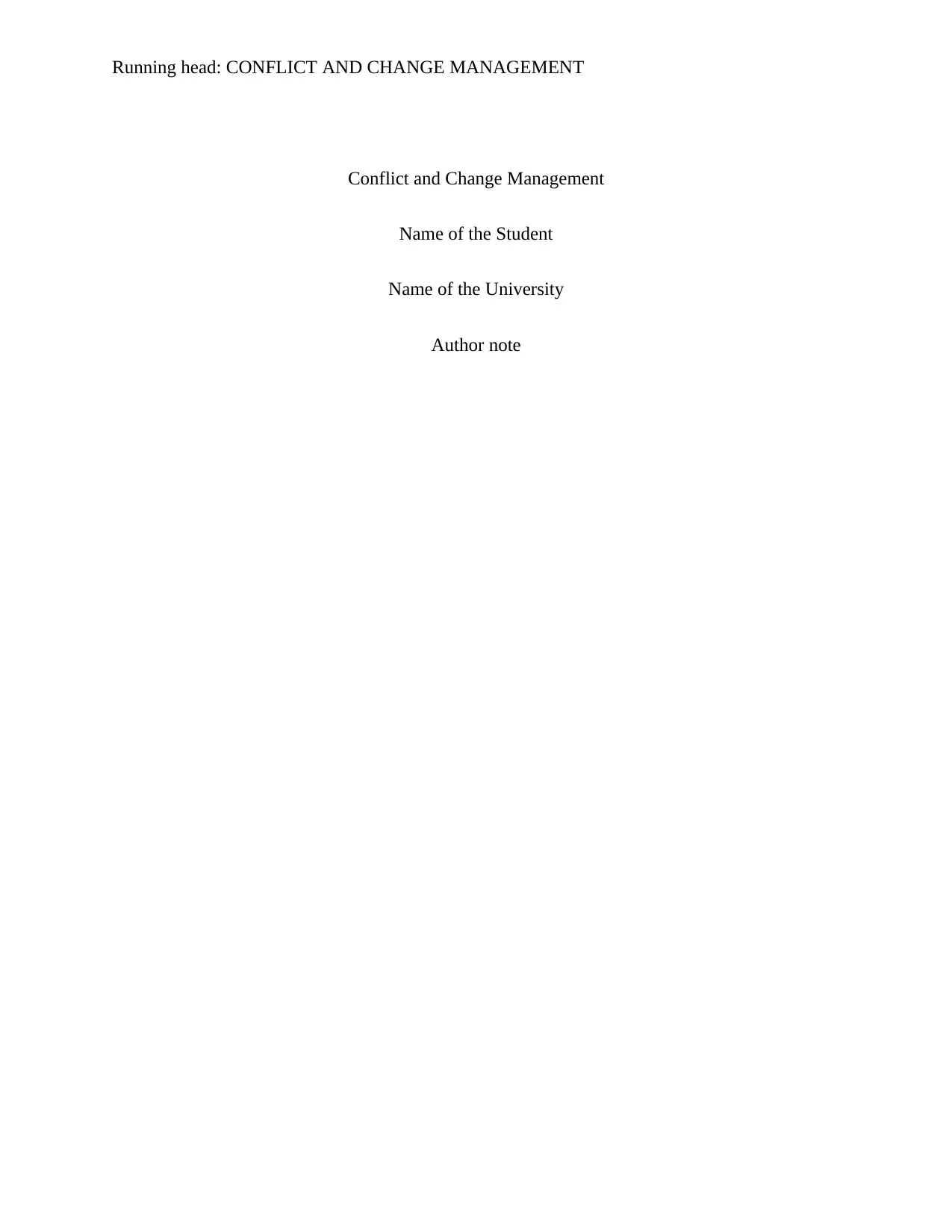
Running head: CONFLICT AND CHANGE MANAGEMENT
Conflict and Change Management
Name of the Student
Name of the University
Author note
Conflict and Change Management
Name of the Student
Name of the University
Author note
Paraphrase This Document
Need a fresh take? Get an instant paraphrase of this document with our AI Paraphraser
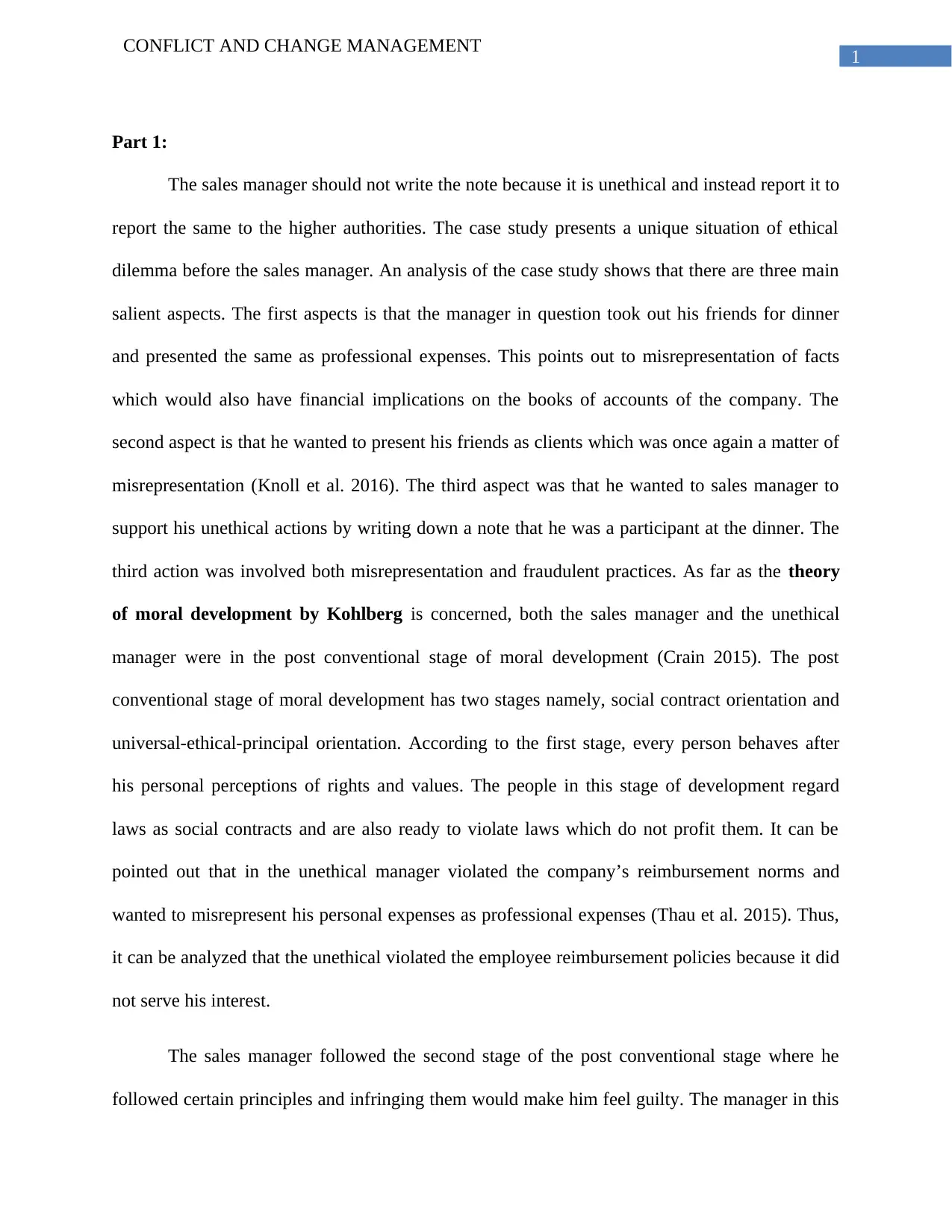
1
CONFLICT AND CHANGE MANAGEMENT
Part 1:
The sales manager should not write the note because it is unethical and instead report it to
report the same to the higher authorities. The case study presents a unique situation of ethical
dilemma before the sales manager. An analysis of the case study shows that there are three main
salient aspects. The first aspects is that the manager in question took out his friends for dinner
and presented the same as professional expenses. This points out to misrepresentation of facts
which would also have financial implications on the books of accounts of the company. The
second aspect is that he wanted to present his friends as clients which was once again a matter of
misrepresentation (Knoll et al. 2016). The third aspect was that he wanted to sales manager to
support his unethical actions by writing down a note that he was a participant at the dinner. The
third action was involved both misrepresentation and fraudulent practices. As far as the theory
of moral development by Kohlberg is concerned, both the sales manager and the unethical
manager were in the post conventional stage of moral development (Crain 2015). The post
conventional stage of moral development has two stages namely, social contract orientation and
universal-ethical-principal orientation. According to the first stage, every person behaves after
his personal perceptions of rights and values. The people in this stage of development regard
laws as social contracts and are also ready to violate laws which do not profit them. It can be
pointed out that in the unethical manager violated the company’s reimbursement norms and
wanted to misrepresent his personal expenses as professional expenses (Thau et al. 2015). Thus,
it can be analyzed that the unethical violated the employee reimbursement policies because it did
not serve his interest.
The sales manager followed the second stage of the post conventional stage where he
followed certain principles and infringing them would make him feel guilty. The manager in this
CONFLICT AND CHANGE MANAGEMENT
Part 1:
The sales manager should not write the note because it is unethical and instead report it to
report the same to the higher authorities. The case study presents a unique situation of ethical
dilemma before the sales manager. An analysis of the case study shows that there are three main
salient aspects. The first aspects is that the manager in question took out his friends for dinner
and presented the same as professional expenses. This points out to misrepresentation of facts
which would also have financial implications on the books of accounts of the company. The
second aspect is that he wanted to present his friends as clients which was once again a matter of
misrepresentation (Knoll et al. 2016). The third aspect was that he wanted to sales manager to
support his unethical actions by writing down a note that he was a participant at the dinner. The
third action was involved both misrepresentation and fraudulent practices. As far as the theory
of moral development by Kohlberg is concerned, both the sales manager and the unethical
manager were in the post conventional stage of moral development (Crain 2015). The post
conventional stage of moral development has two stages namely, social contract orientation and
universal-ethical-principal orientation. According to the first stage, every person behaves after
his personal perceptions of rights and values. The people in this stage of development regard
laws as social contracts and are also ready to violate laws which do not profit them. It can be
pointed out that in the unethical manager violated the company’s reimbursement norms and
wanted to misrepresent his personal expenses as professional expenses (Thau et al. 2015). Thus,
it can be analyzed that the unethical violated the employee reimbursement policies because it did
not serve his interest.
The sales manager followed the second stage of the post conventional stage where he
followed certain principles and infringing them would make him feel guilty. The manager in this
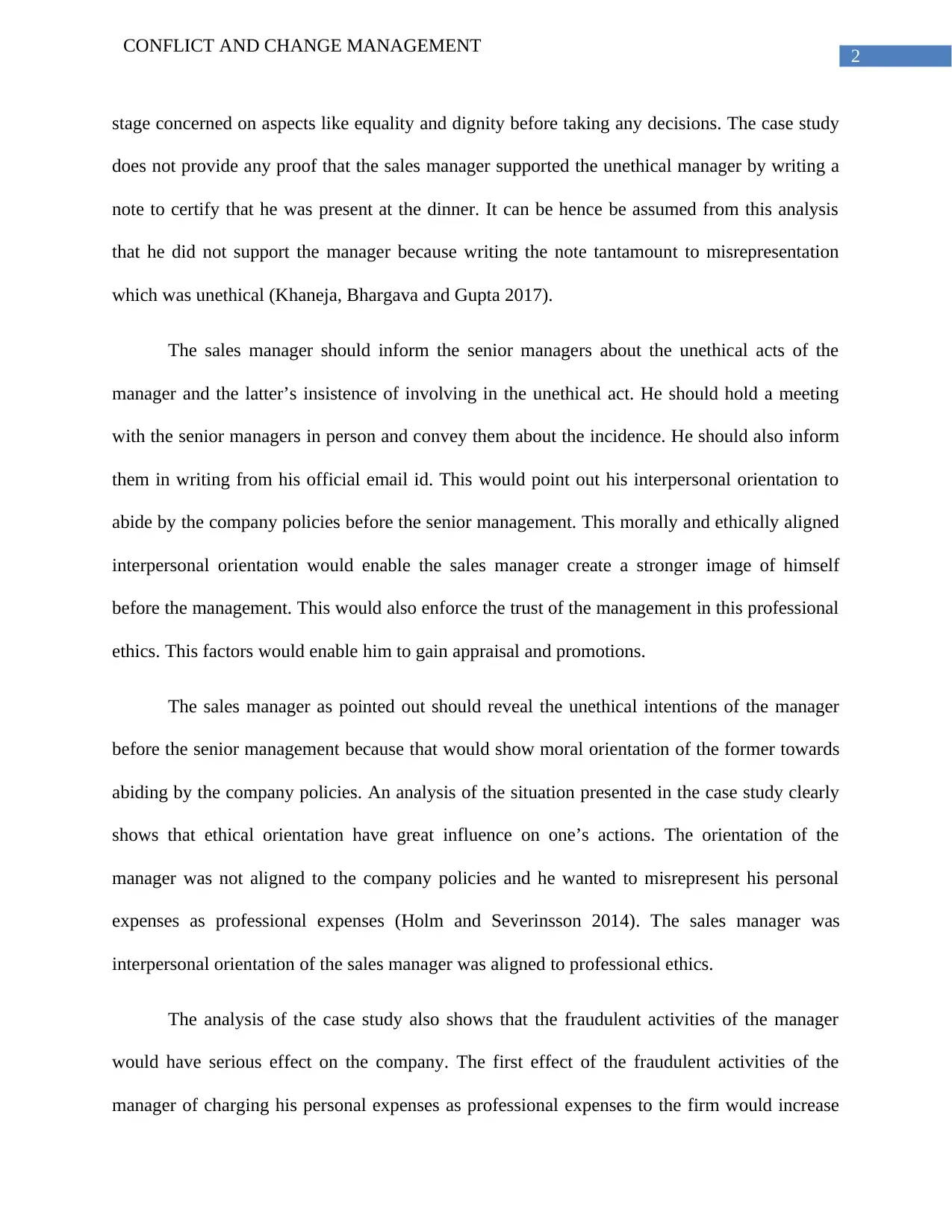
2
CONFLICT AND CHANGE MANAGEMENT
stage concerned on aspects like equality and dignity before taking any decisions. The case study
does not provide any proof that the sales manager supported the unethical manager by writing a
note to certify that he was present at the dinner. It can be hence be assumed from this analysis
that he did not support the manager because writing the note tantamount to misrepresentation
which was unethical (Khaneja, Bhargava and Gupta 2017).
The sales manager should inform the senior managers about the unethical acts of the
manager and the latter’s insistence of involving in the unethical act. He should hold a meeting
with the senior managers in person and convey them about the incidence. He should also inform
them in writing from his official email id. This would point out his interpersonal orientation to
abide by the company policies before the senior management. This morally and ethically aligned
interpersonal orientation would enable the sales manager create a stronger image of himself
before the management. This would also enforce the trust of the management in this professional
ethics. This factors would enable him to gain appraisal and promotions.
The sales manager as pointed out should reveal the unethical intentions of the manager
before the senior management because that would show moral orientation of the former towards
abiding by the company policies. An analysis of the situation presented in the case study clearly
shows that ethical orientation have great influence on one’s actions. The orientation of the
manager was not aligned to the company policies and he wanted to misrepresent his personal
expenses as professional expenses (Holm and Severinsson 2014). The sales manager was
interpersonal orientation of the sales manager was aligned to professional ethics.
The analysis of the case study also shows that the fraudulent activities of the manager
would have serious effect on the company. The first effect of the fraudulent activities of the
manager of charging his personal expenses as professional expenses to the firm would increase
CONFLICT AND CHANGE MANAGEMENT
stage concerned on aspects like equality and dignity before taking any decisions. The case study
does not provide any proof that the sales manager supported the unethical manager by writing a
note to certify that he was present at the dinner. It can be hence be assumed from this analysis
that he did not support the manager because writing the note tantamount to misrepresentation
which was unethical (Khaneja, Bhargava and Gupta 2017).
The sales manager should inform the senior managers about the unethical acts of the
manager and the latter’s insistence of involving in the unethical act. He should hold a meeting
with the senior managers in person and convey them about the incidence. He should also inform
them in writing from his official email id. This would point out his interpersonal orientation to
abide by the company policies before the senior management. This morally and ethically aligned
interpersonal orientation would enable the sales manager create a stronger image of himself
before the management. This would also enforce the trust of the management in this professional
ethics. This factors would enable him to gain appraisal and promotions.
The sales manager as pointed out should reveal the unethical intentions of the manager
before the senior management because that would show moral orientation of the former towards
abiding by the company policies. An analysis of the situation presented in the case study clearly
shows that ethical orientation have great influence on one’s actions. The orientation of the
manager was not aligned to the company policies and he wanted to misrepresent his personal
expenses as professional expenses (Holm and Severinsson 2014). The sales manager was
interpersonal orientation of the sales manager was aligned to professional ethics.
The analysis of the case study also shows that the fraudulent activities of the manager
would have serious effect on the company. The first effect of the fraudulent activities of the
manager of charging his personal expenses as professional expenses to the firm would increase
⊘ This is a preview!⊘
Do you want full access?
Subscribe today to unlock all pages.

Trusted by 1+ million students worldwide
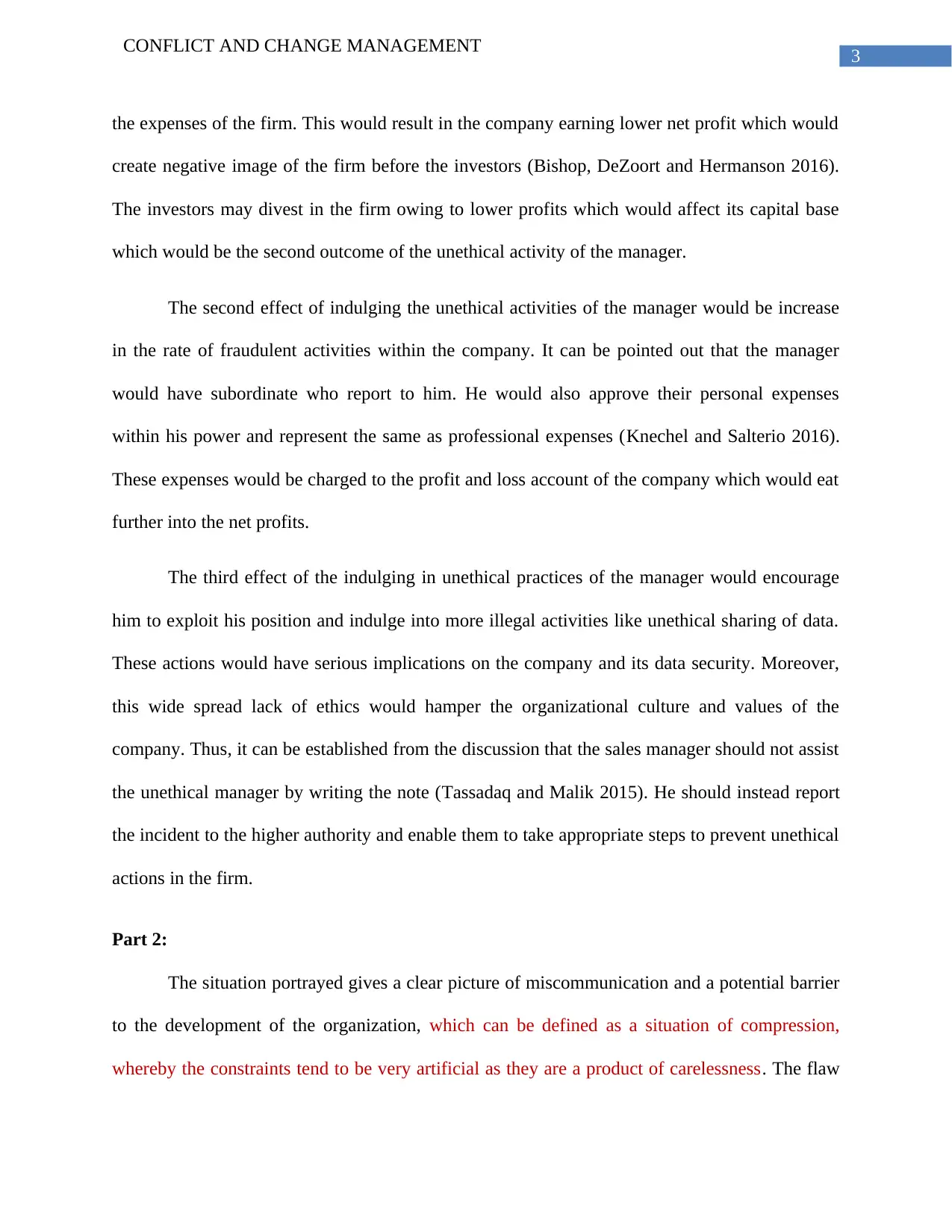
3
CONFLICT AND CHANGE MANAGEMENT
the expenses of the firm. This would result in the company earning lower net profit which would
create negative image of the firm before the investors (Bishop, DeZoort and Hermanson 2016).
The investors may divest in the firm owing to lower profits which would affect its capital base
which would be the second outcome of the unethical activity of the manager.
The second effect of indulging the unethical activities of the manager would be increase
in the rate of fraudulent activities within the company. It can be pointed out that the manager
would have subordinate who report to him. He would also approve their personal expenses
within his power and represent the same as professional expenses (Knechel and Salterio 2016).
These expenses would be charged to the profit and loss account of the company which would eat
further into the net profits.
The third effect of the indulging in unethical practices of the manager would encourage
him to exploit his position and indulge into more illegal activities like unethical sharing of data.
These actions would have serious implications on the company and its data security. Moreover,
this wide spread lack of ethics would hamper the organizational culture and values of the
company. Thus, it can be established from the discussion that the sales manager should not assist
the unethical manager by writing the note (Tassadaq and Malik 2015). He should instead report
the incident to the higher authority and enable them to take appropriate steps to prevent unethical
actions in the firm.
Part 2:
The situation portrayed gives a clear picture of miscommunication and a potential barrier
to the development of the organization, which can be defined as a situation of compression,
whereby the constraints tend to be very artificial as they are a product of carelessness. The flaw
CONFLICT AND CHANGE MANAGEMENT
the expenses of the firm. This would result in the company earning lower net profit which would
create negative image of the firm before the investors (Bishop, DeZoort and Hermanson 2016).
The investors may divest in the firm owing to lower profits which would affect its capital base
which would be the second outcome of the unethical activity of the manager.
The second effect of indulging the unethical activities of the manager would be increase
in the rate of fraudulent activities within the company. It can be pointed out that the manager
would have subordinate who report to him. He would also approve their personal expenses
within his power and represent the same as professional expenses (Knechel and Salterio 2016).
These expenses would be charged to the profit and loss account of the company which would eat
further into the net profits.
The third effect of the indulging in unethical practices of the manager would encourage
him to exploit his position and indulge into more illegal activities like unethical sharing of data.
These actions would have serious implications on the company and its data security. Moreover,
this wide spread lack of ethics would hamper the organizational culture and values of the
company. Thus, it can be established from the discussion that the sales manager should not assist
the unethical manager by writing the note (Tassadaq and Malik 2015). He should instead report
the incident to the higher authority and enable them to take appropriate steps to prevent unethical
actions in the firm.
Part 2:
The situation portrayed gives a clear picture of miscommunication and a potential barrier
to the development of the organization, which can be defined as a situation of compression,
whereby the constraints tend to be very artificial as they are a product of carelessness. The flaw
Paraphrase This Document
Need a fresh take? Get an instant paraphrase of this document with our AI Paraphraser
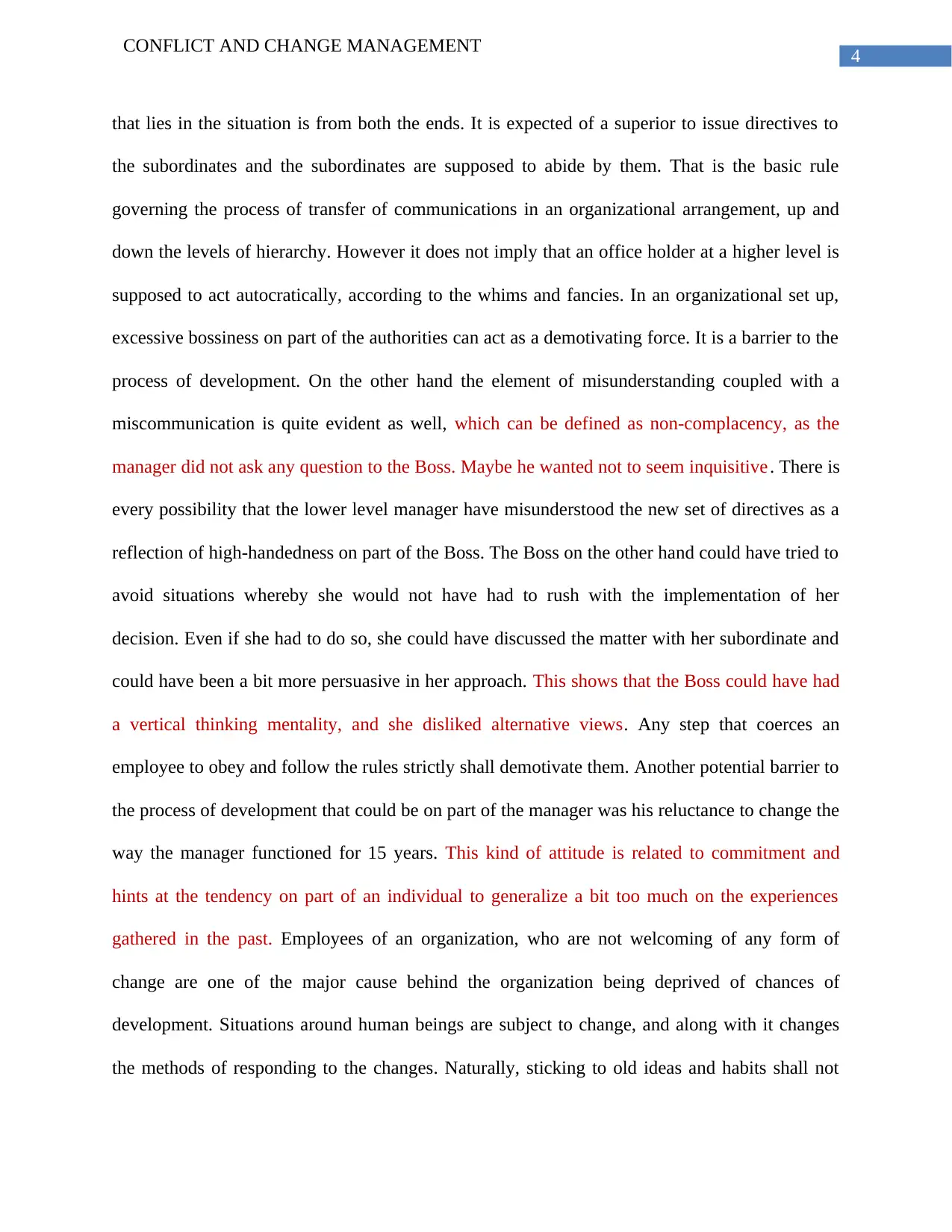
4
CONFLICT AND CHANGE MANAGEMENT
that lies in the situation is from both the ends. It is expected of a superior to issue directives to
the subordinates and the subordinates are supposed to abide by them. That is the basic rule
governing the process of transfer of communications in an organizational arrangement, up and
down the levels of hierarchy. However it does not imply that an office holder at a higher level is
supposed to act autocratically, according to the whims and fancies. In an organizational set up,
excessive bossiness on part of the authorities can act as a demotivating force. It is a barrier to the
process of development. On the other hand the element of misunderstanding coupled with a
miscommunication is quite evident as well, which can be defined as non-complacency, as the
manager did not ask any question to the Boss. Maybe he wanted not to seem inquisitive . There is
every possibility that the lower level manager have misunderstood the new set of directives as a
reflection of high-handedness on part of the Boss. The Boss on the other hand could have tried to
avoid situations whereby she would not have had to rush with the implementation of her
decision. Even if she had to do so, she could have discussed the matter with her subordinate and
could have been a bit more persuasive in her approach. This shows that the Boss could have had
a vertical thinking mentality, and she disliked alternative views. Any step that coerces an
employee to obey and follow the rules strictly shall demotivate them. Another potential barrier to
the process of development that could be on part of the manager was his reluctance to change the
way the manager functioned for 15 years. This kind of attitude is related to commitment and
hints at the tendency on part of an individual to generalize a bit too much on the experiences
gathered in the past. Employees of an organization, who are not welcoming of any form of
change are one of the major cause behind the organization being deprived of chances of
development. Situations around human beings are subject to change, and along with it changes
the methods of responding to the changes. Naturally, sticking to old ideas and habits shall not
CONFLICT AND CHANGE MANAGEMENT
that lies in the situation is from both the ends. It is expected of a superior to issue directives to
the subordinates and the subordinates are supposed to abide by them. That is the basic rule
governing the process of transfer of communications in an organizational arrangement, up and
down the levels of hierarchy. However it does not imply that an office holder at a higher level is
supposed to act autocratically, according to the whims and fancies. In an organizational set up,
excessive bossiness on part of the authorities can act as a demotivating force. It is a barrier to the
process of development. On the other hand the element of misunderstanding coupled with a
miscommunication is quite evident as well, which can be defined as non-complacency, as the
manager did not ask any question to the Boss. Maybe he wanted not to seem inquisitive . There is
every possibility that the lower level manager have misunderstood the new set of directives as a
reflection of high-handedness on part of the Boss. The Boss on the other hand could have tried to
avoid situations whereby she would not have had to rush with the implementation of her
decision. Even if she had to do so, she could have discussed the matter with her subordinate and
could have been a bit more persuasive in her approach. This shows that the Boss could have had
a vertical thinking mentality, and she disliked alternative views. Any step that coerces an
employee to obey and follow the rules strictly shall demotivate them. Another potential barrier to
the process of development that could be on part of the manager was his reluctance to change the
way the manager functioned for 15 years. This kind of attitude is related to commitment and
hints at the tendency on part of an individual to generalize a bit too much on the experiences
gathered in the past. Employees of an organization, who are not welcoming of any form of
change are one of the major cause behind the organization being deprived of chances of
development. Situations around human beings are subject to change, and along with it changes
the methods of responding to the changes. Naturally, sticking to old ideas and habits shall not
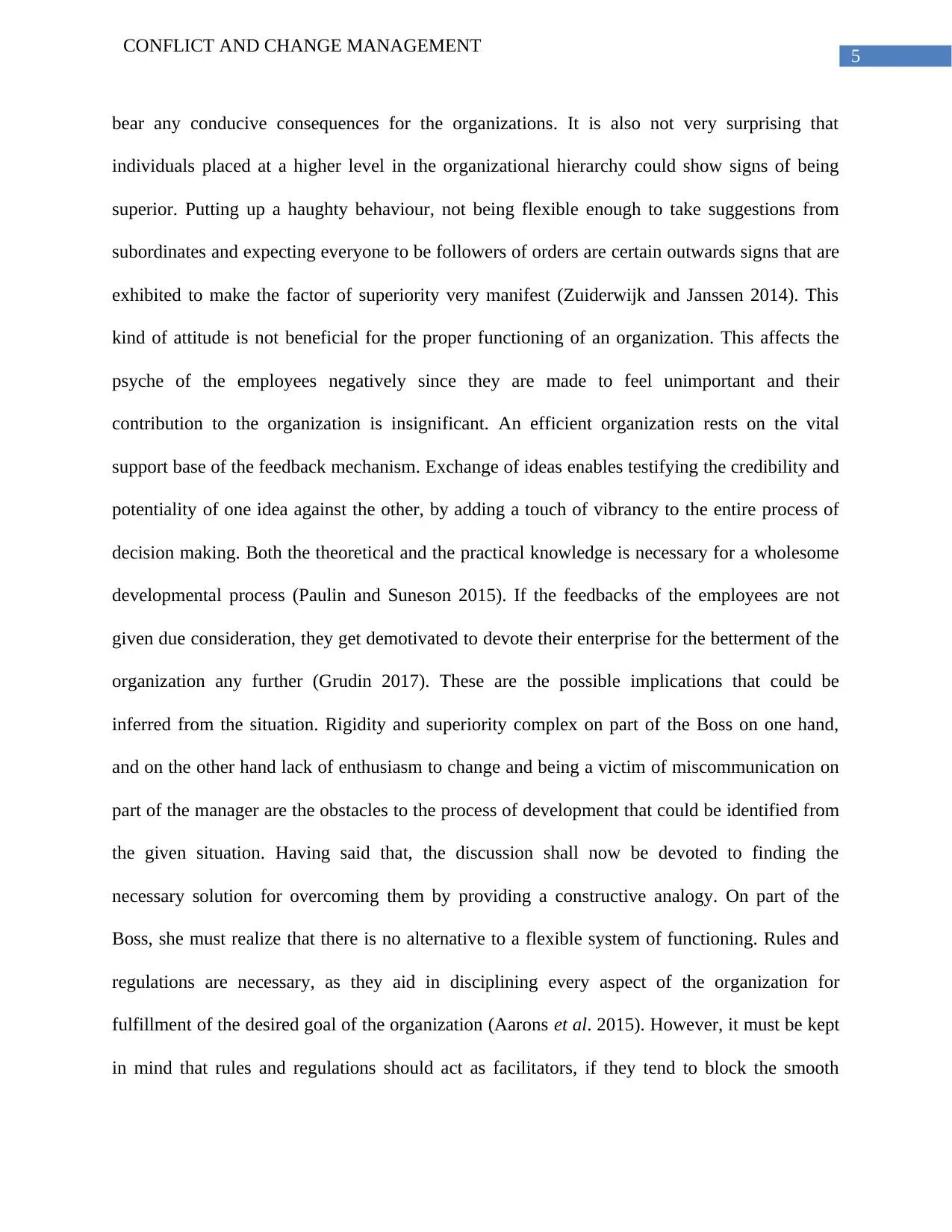
5
CONFLICT AND CHANGE MANAGEMENT
bear any conducive consequences for the organizations. It is also not very surprising that
individuals placed at a higher level in the organizational hierarchy could show signs of being
superior. Putting up a haughty behaviour, not being flexible enough to take suggestions from
subordinates and expecting everyone to be followers of orders are certain outwards signs that are
exhibited to make the factor of superiority very manifest (Zuiderwijk and Janssen 2014). This
kind of attitude is not beneficial for the proper functioning of an organization. This affects the
psyche of the employees negatively since they are made to feel unimportant and their
contribution to the organization is insignificant. An efficient organization rests on the vital
support base of the feedback mechanism. Exchange of ideas enables testifying the credibility and
potentiality of one idea against the other, by adding a touch of vibrancy to the entire process of
decision making. Both the theoretical and the practical knowledge is necessary for a wholesome
developmental process (Paulin and Suneson 2015). If the feedbacks of the employees are not
given due consideration, they get demotivated to devote their enterprise for the betterment of the
organization any further (Grudin 2017). These are the possible implications that could be
inferred from the situation. Rigidity and superiority complex on part of the Boss on one hand,
and on the other hand lack of enthusiasm to change and being a victim of miscommunication on
part of the manager are the obstacles to the process of development that could be identified from
the given situation. Having said that, the discussion shall now be devoted to finding the
necessary solution for overcoming them by providing a constructive analogy. On part of the
Boss, she must realize that there is no alternative to a flexible system of functioning. Rules and
regulations are necessary, as they aid in disciplining every aspect of the organization for
fulfillment of the desired goal of the organization (Aarons et al. 2015). However, it must be kept
in mind that rules and regulations should act as facilitators, if they tend to block the smooth
CONFLICT AND CHANGE MANAGEMENT
bear any conducive consequences for the organizations. It is also not very surprising that
individuals placed at a higher level in the organizational hierarchy could show signs of being
superior. Putting up a haughty behaviour, not being flexible enough to take suggestions from
subordinates and expecting everyone to be followers of orders are certain outwards signs that are
exhibited to make the factor of superiority very manifest (Zuiderwijk and Janssen 2014). This
kind of attitude is not beneficial for the proper functioning of an organization. This affects the
psyche of the employees negatively since they are made to feel unimportant and their
contribution to the organization is insignificant. An efficient organization rests on the vital
support base of the feedback mechanism. Exchange of ideas enables testifying the credibility and
potentiality of one idea against the other, by adding a touch of vibrancy to the entire process of
decision making. Both the theoretical and the practical knowledge is necessary for a wholesome
developmental process (Paulin and Suneson 2015). If the feedbacks of the employees are not
given due consideration, they get demotivated to devote their enterprise for the betterment of the
organization any further (Grudin 2017). These are the possible implications that could be
inferred from the situation. Rigidity and superiority complex on part of the Boss on one hand,
and on the other hand lack of enthusiasm to change and being a victim of miscommunication on
part of the manager are the obstacles to the process of development that could be identified from
the given situation. Having said that, the discussion shall now be devoted to finding the
necessary solution for overcoming them by providing a constructive analogy. On part of the
Boss, she must realize that there is no alternative to a flexible system of functioning. Rules and
regulations are necessary, as they aid in disciplining every aspect of the organization for
fulfillment of the desired goal of the organization (Aarons et al. 2015). However, it must be kept
in mind that rules and regulations should act as facilitators, if they tend to block the smooth
⊘ This is a preview!⊘
Do you want full access?
Subscribe today to unlock all pages.

Trusted by 1+ million students worldwide
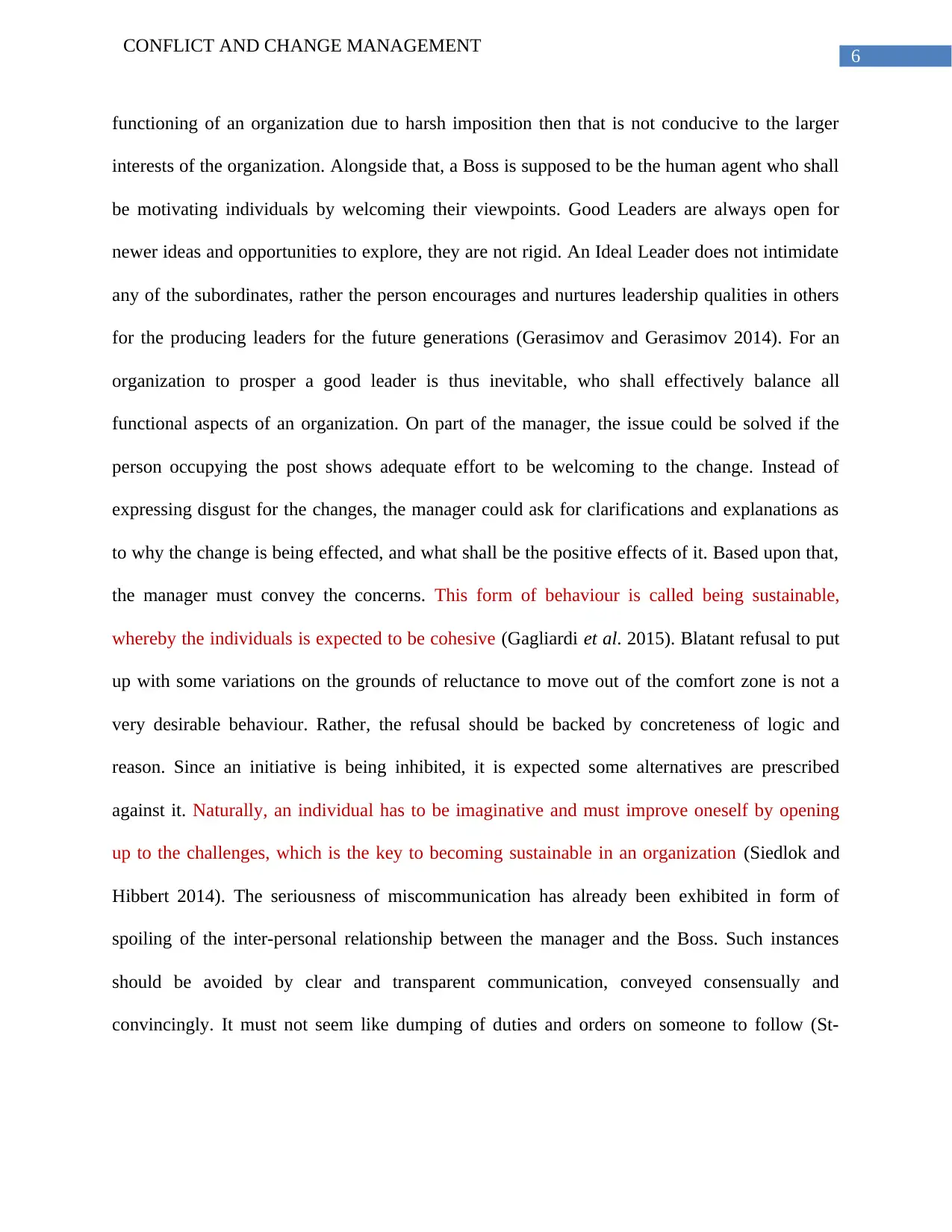
6
CONFLICT AND CHANGE MANAGEMENT
functioning of an organization due to harsh imposition then that is not conducive to the larger
interests of the organization. Alongside that, a Boss is supposed to be the human agent who shall
be motivating individuals by welcoming their viewpoints. Good Leaders are always open for
newer ideas and opportunities to explore, they are not rigid. An Ideal Leader does not intimidate
any of the subordinates, rather the person encourages and nurtures leadership qualities in others
for the producing leaders for the future generations (Gerasimov and Gerasimov 2014). For an
organization to prosper a good leader is thus inevitable, who shall effectively balance all
functional aspects of an organization. On part of the manager, the issue could be solved if the
person occupying the post shows adequate effort to be welcoming to the change. Instead of
expressing disgust for the changes, the manager could ask for clarifications and explanations as
to why the change is being effected, and what shall be the positive effects of it. Based upon that,
the manager must convey the concerns. This form of behaviour is called being sustainable,
whereby the individuals is expected to be cohesive (Gagliardi et al. 2015). Blatant refusal to put
up with some variations on the grounds of reluctance to move out of the comfort zone is not a
very desirable behaviour. Rather, the refusal should be backed by concreteness of logic and
reason. Since an initiative is being inhibited, it is expected some alternatives are prescribed
against it. Naturally, an individual has to be imaginative and must improve oneself by opening
up to the challenges, which is the key to becoming sustainable in an organization (Siedlok and
Hibbert 2014). The seriousness of miscommunication has already been exhibited in form of
spoiling of the inter-personal relationship between the manager and the Boss. Such instances
should be avoided by clear and transparent communication, conveyed consensually and
convincingly. It must not seem like dumping of duties and orders on someone to follow (St-
CONFLICT AND CHANGE MANAGEMENT
functioning of an organization due to harsh imposition then that is not conducive to the larger
interests of the organization. Alongside that, a Boss is supposed to be the human agent who shall
be motivating individuals by welcoming their viewpoints. Good Leaders are always open for
newer ideas and opportunities to explore, they are not rigid. An Ideal Leader does not intimidate
any of the subordinates, rather the person encourages and nurtures leadership qualities in others
for the producing leaders for the future generations (Gerasimov and Gerasimov 2014). For an
organization to prosper a good leader is thus inevitable, who shall effectively balance all
functional aspects of an organization. On part of the manager, the issue could be solved if the
person occupying the post shows adequate effort to be welcoming to the change. Instead of
expressing disgust for the changes, the manager could ask for clarifications and explanations as
to why the change is being effected, and what shall be the positive effects of it. Based upon that,
the manager must convey the concerns. This form of behaviour is called being sustainable,
whereby the individuals is expected to be cohesive (Gagliardi et al. 2015). Blatant refusal to put
up with some variations on the grounds of reluctance to move out of the comfort zone is not a
very desirable behaviour. Rather, the refusal should be backed by concreteness of logic and
reason. Since an initiative is being inhibited, it is expected some alternatives are prescribed
against it. Naturally, an individual has to be imaginative and must improve oneself by opening
up to the challenges, which is the key to becoming sustainable in an organization (Siedlok and
Hibbert 2014). The seriousness of miscommunication has already been exhibited in form of
spoiling of the inter-personal relationship between the manager and the Boss. Such instances
should be avoided by clear and transparent communication, conveyed consensually and
convincingly. It must not seem like dumping of duties and orders on someone to follow (St-
Paraphrase This Document
Need a fresh take? Get an instant paraphrase of this document with our AI Paraphraser
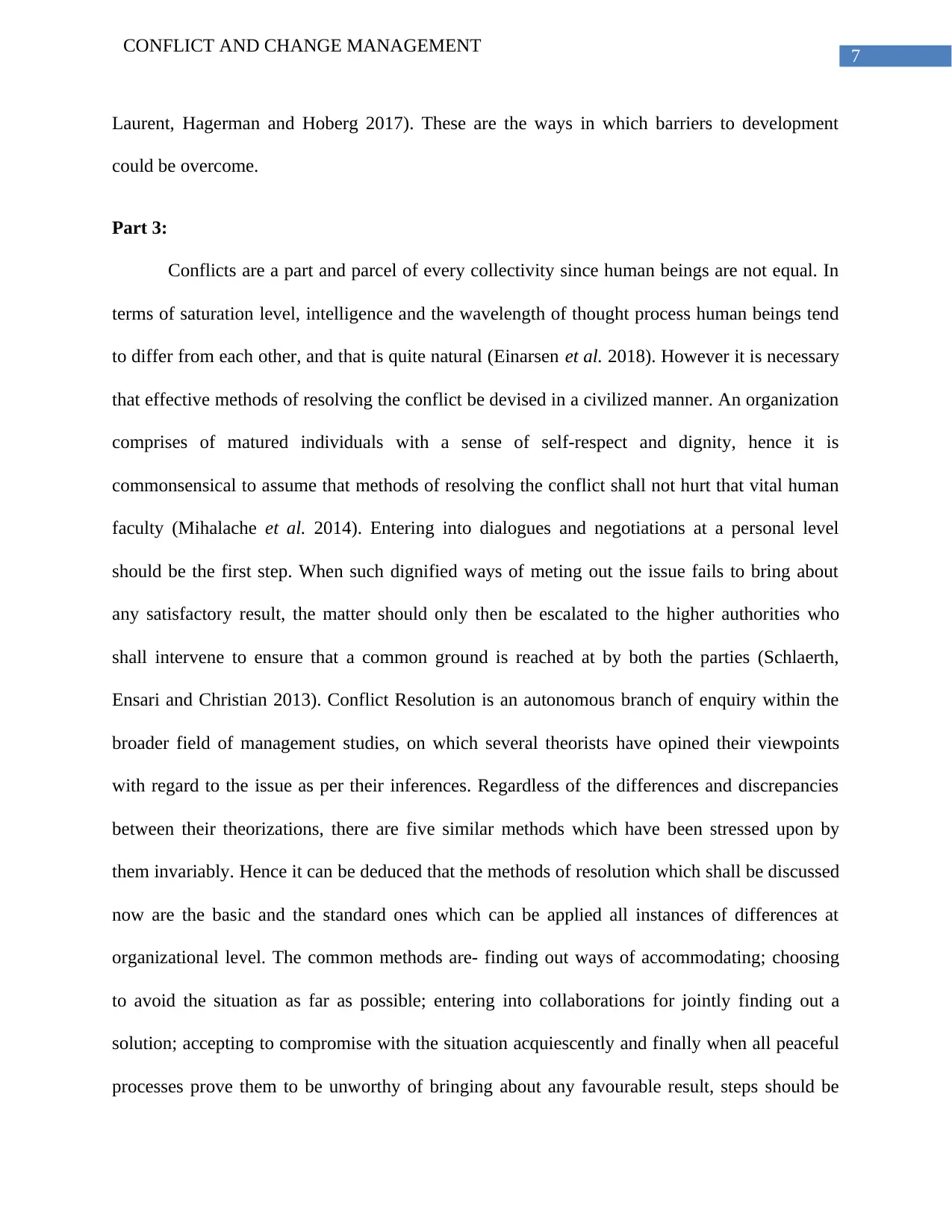
7
CONFLICT AND CHANGE MANAGEMENT
Laurent, Hagerman and Hoberg 2017). These are the ways in which barriers to development
could be overcome.
Part 3:
Conflicts are a part and parcel of every collectivity since human beings are not equal. In
terms of saturation level, intelligence and the wavelength of thought process human beings tend
to differ from each other, and that is quite natural (Einarsen et al. 2018). However it is necessary
that effective methods of resolving the conflict be devised in a civilized manner. An organization
comprises of matured individuals with a sense of self-respect and dignity, hence it is
commonsensical to assume that methods of resolving the conflict shall not hurt that vital human
faculty (Mihalache et al. 2014). Entering into dialogues and negotiations at a personal level
should be the first step. When such dignified ways of meting out the issue fails to bring about
any satisfactory result, the matter should only then be escalated to the higher authorities who
shall intervene to ensure that a common ground is reached at by both the parties (Schlaerth,
Ensari and Christian 2013). Conflict Resolution is an autonomous branch of enquiry within the
broader field of management studies, on which several theorists have opined their viewpoints
with regard to the issue as per their inferences. Regardless of the differences and discrepancies
between their theorizations, there are five similar methods which have been stressed upon by
them invariably. Hence it can be deduced that the methods of resolution which shall be discussed
now are the basic and the standard ones which can be applied all instances of differences at
organizational level. The common methods are- finding out ways of accommodating; choosing
to avoid the situation as far as possible; entering into collaborations for jointly finding out a
solution; accepting to compromise with the situation acquiescently and finally when all peaceful
processes prove them to be unworthy of bringing about any favourable result, steps should be
CONFLICT AND CHANGE MANAGEMENT
Laurent, Hagerman and Hoberg 2017). These are the ways in which barriers to development
could be overcome.
Part 3:
Conflicts are a part and parcel of every collectivity since human beings are not equal. In
terms of saturation level, intelligence and the wavelength of thought process human beings tend
to differ from each other, and that is quite natural (Einarsen et al. 2018). However it is necessary
that effective methods of resolving the conflict be devised in a civilized manner. An organization
comprises of matured individuals with a sense of self-respect and dignity, hence it is
commonsensical to assume that methods of resolving the conflict shall not hurt that vital human
faculty (Mihalache et al. 2014). Entering into dialogues and negotiations at a personal level
should be the first step. When such dignified ways of meting out the issue fails to bring about
any satisfactory result, the matter should only then be escalated to the higher authorities who
shall intervene to ensure that a common ground is reached at by both the parties (Schlaerth,
Ensari and Christian 2013). Conflict Resolution is an autonomous branch of enquiry within the
broader field of management studies, on which several theorists have opined their viewpoints
with regard to the issue as per their inferences. Regardless of the differences and discrepancies
between their theorizations, there are five similar methods which have been stressed upon by
them invariably. Hence it can be deduced that the methods of resolution which shall be discussed
now are the basic and the standard ones which can be applied all instances of differences at
organizational level. The common methods are- finding out ways of accommodating; choosing
to avoid the situation as far as possible; entering into collaborations for jointly finding out a
solution; accepting to compromise with the situation acquiescently and finally when all peaceful
processes prove them to be unworthy of bringing about any favourable result, steps should be
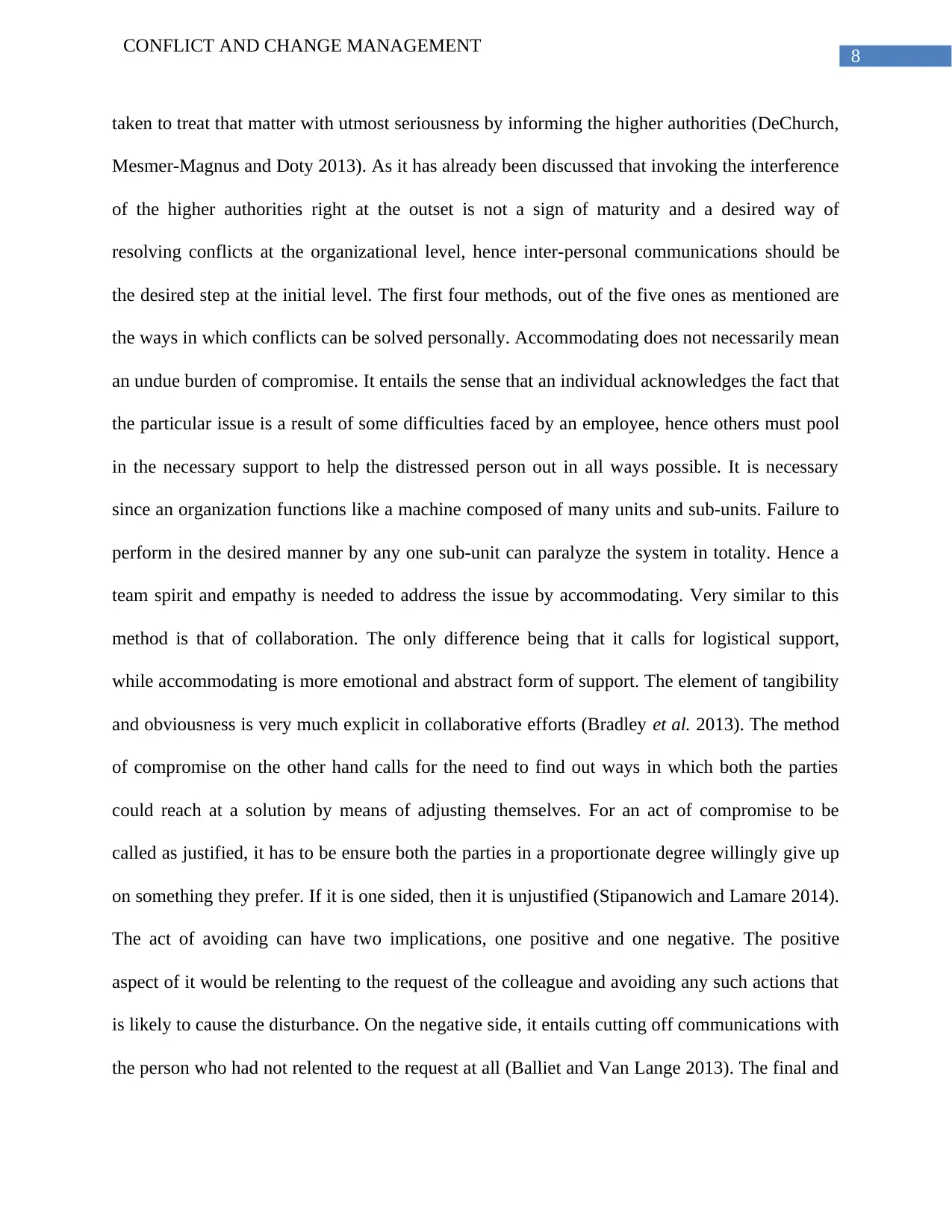
8
CONFLICT AND CHANGE MANAGEMENT
taken to treat that matter with utmost seriousness by informing the higher authorities (DeChurch,
Mesmer-Magnus and Doty 2013). As it has already been discussed that invoking the interference
of the higher authorities right at the outset is not a sign of maturity and a desired way of
resolving conflicts at the organizational level, hence inter-personal communications should be
the desired step at the initial level. The first four methods, out of the five ones as mentioned are
the ways in which conflicts can be solved personally. Accommodating does not necessarily mean
an undue burden of compromise. It entails the sense that an individual acknowledges the fact that
the particular issue is a result of some difficulties faced by an employee, hence others must pool
in the necessary support to help the distressed person out in all ways possible. It is necessary
since an organization functions like a machine composed of many units and sub-units. Failure to
perform in the desired manner by any one sub-unit can paralyze the system in totality. Hence a
team spirit and empathy is needed to address the issue by accommodating. Very similar to this
method is that of collaboration. The only difference being that it calls for logistical support,
while accommodating is more emotional and abstract form of support. The element of tangibility
and obviousness is very much explicit in collaborative efforts (Bradley et al. 2013). The method
of compromise on the other hand calls for the need to find out ways in which both the parties
could reach at a solution by means of adjusting themselves. For an act of compromise to be
called as justified, it has to be ensure both the parties in a proportionate degree willingly give up
on something they prefer. If it is one sided, then it is unjustified (Stipanowich and Lamare 2014).
The act of avoiding can have two implications, one positive and one negative. The positive
aspect of it would be relenting to the request of the colleague and avoiding any such actions that
is likely to cause the disturbance. On the negative side, it entails cutting off communications with
the person who had not relented to the request at all (Balliet and Van Lange 2013). The final and
CONFLICT AND CHANGE MANAGEMENT
taken to treat that matter with utmost seriousness by informing the higher authorities (DeChurch,
Mesmer-Magnus and Doty 2013). As it has already been discussed that invoking the interference
of the higher authorities right at the outset is not a sign of maturity and a desired way of
resolving conflicts at the organizational level, hence inter-personal communications should be
the desired step at the initial level. The first four methods, out of the five ones as mentioned are
the ways in which conflicts can be solved personally. Accommodating does not necessarily mean
an undue burden of compromise. It entails the sense that an individual acknowledges the fact that
the particular issue is a result of some difficulties faced by an employee, hence others must pool
in the necessary support to help the distressed person out in all ways possible. It is necessary
since an organization functions like a machine composed of many units and sub-units. Failure to
perform in the desired manner by any one sub-unit can paralyze the system in totality. Hence a
team spirit and empathy is needed to address the issue by accommodating. Very similar to this
method is that of collaboration. The only difference being that it calls for logistical support,
while accommodating is more emotional and abstract form of support. The element of tangibility
and obviousness is very much explicit in collaborative efforts (Bradley et al. 2013). The method
of compromise on the other hand calls for the need to find out ways in which both the parties
could reach at a solution by means of adjusting themselves. For an act of compromise to be
called as justified, it has to be ensure both the parties in a proportionate degree willingly give up
on something they prefer. If it is one sided, then it is unjustified (Stipanowich and Lamare 2014).
The act of avoiding can have two implications, one positive and one negative. The positive
aspect of it would be relenting to the request of the colleague and avoiding any such actions that
is likely to cause the disturbance. On the negative side, it entails cutting off communications with
the person who had not relented to the request at all (Balliet and Van Lange 2013). The final and
⊘ This is a preview!⊘
Do you want full access?
Subscribe today to unlock all pages.

Trusted by 1+ million students worldwide
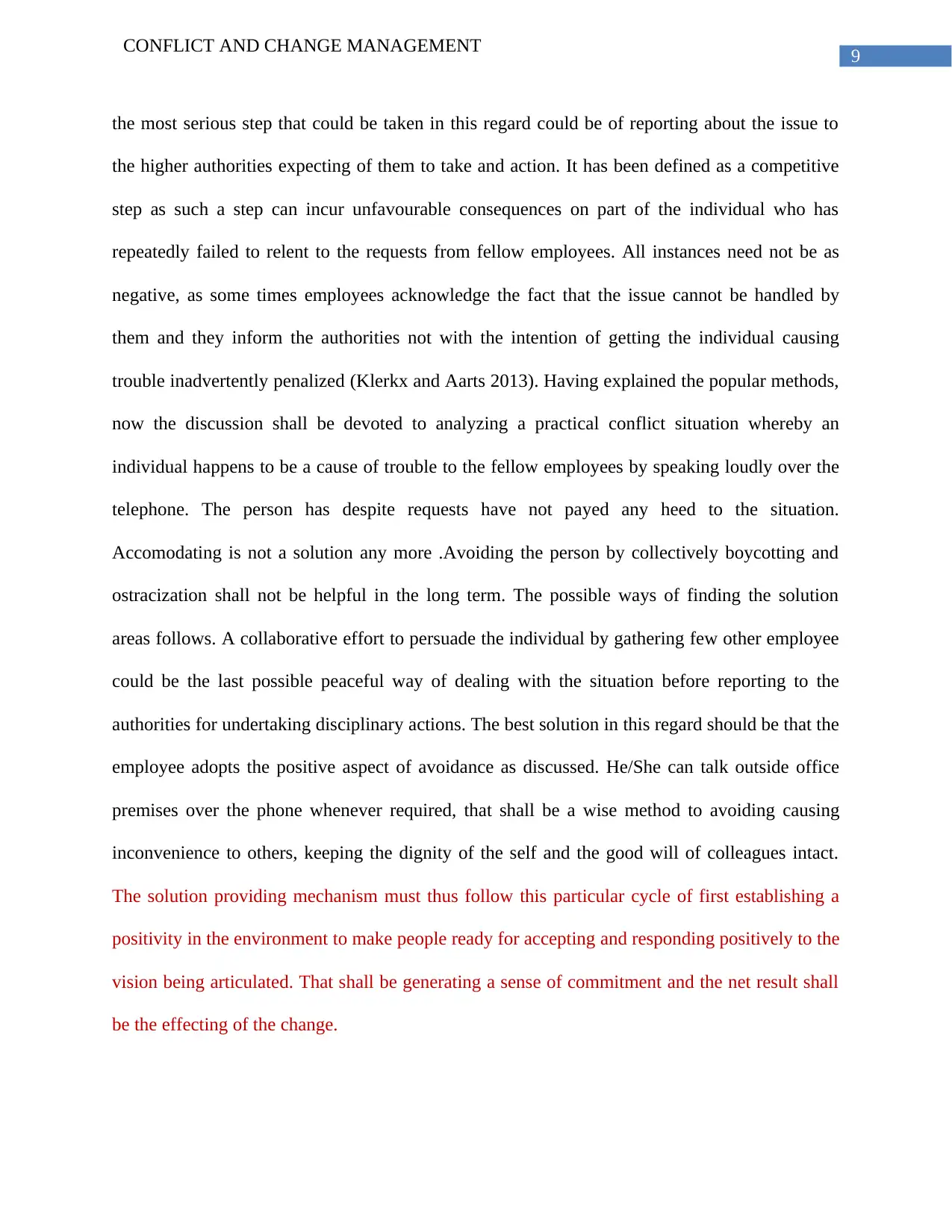
9
CONFLICT AND CHANGE MANAGEMENT
the most serious step that could be taken in this regard could be of reporting about the issue to
the higher authorities expecting of them to take and action. It has been defined as a competitive
step as such a step can incur unfavourable consequences on part of the individual who has
repeatedly failed to relent to the requests from fellow employees. All instances need not be as
negative, as some times employees acknowledge the fact that the issue cannot be handled by
them and they inform the authorities not with the intention of getting the individual causing
trouble inadvertently penalized (Klerkx and Aarts 2013). Having explained the popular methods,
now the discussion shall be devoted to analyzing a practical conflict situation whereby an
individual happens to be a cause of trouble to the fellow employees by speaking loudly over the
telephone. The person has despite requests have not payed any heed to the situation.
Accomodating is not a solution any more .Avoiding the person by collectively boycotting and
ostracization shall not be helpful in the long term. The possible ways of finding the solution
areas follows. A collaborative effort to persuade the individual by gathering few other employee
could be the last possible peaceful way of dealing with the situation before reporting to the
authorities for undertaking disciplinary actions. The best solution in this regard should be that the
employee adopts the positive aspect of avoidance as discussed. He/She can talk outside office
premises over the phone whenever required, that shall be a wise method to avoiding causing
inconvenience to others, keeping the dignity of the self and the good will of colleagues intact.
The solution providing mechanism must thus follow this particular cycle of first establishing a
positivity in the environment to make people ready for accepting and responding positively to the
vision being articulated. That shall be generating a sense of commitment and the net result shall
be the effecting of the change.
CONFLICT AND CHANGE MANAGEMENT
the most serious step that could be taken in this regard could be of reporting about the issue to
the higher authorities expecting of them to take and action. It has been defined as a competitive
step as such a step can incur unfavourable consequences on part of the individual who has
repeatedly failed to relent to the requests from fellow employees. All instances need not be as
negative, as some times employees acknowledge the fact that the issue cannot be handled by
them and they inform the authorities not with the intention of getting the individual causing
trouble inadvertently penalized (Klerkx and Aarts 2013). Having explained the popular methods,
now the discussion shall be devoted to analyzing a practical conflict situation whereby an
individual happens to be a cause of trouble to the fellow employees by speaking loudly over the
telephone. The person has despite requests have not payed any heed to the situation.
Accomodating is not a solution any more .Avoiding the person by collectively boycotting and
ostracization shall not be helpful in the long term. The possible ways of finding the solution
areas follows. A collaborative effort to persuade the individual by gathering few other employee
could be the last possible peaceful way of dealing with the situation before reporting to the
authorities for undertaking disciplinary actions. The best solution in this regard should be that the
employee adopts the positive aspect of avoidance as discussed. He/She can talk outside office
premises over the phone whenever required, that shall be a wise method to avoiding causing
inconvenience to others, keeping the dignity of the self and the good will of colleagues intact.
The solution providing mechanism must thus follow this particular cycle of first establishing a
positivity in the environment to make people ready for accepting and responding positively to the
vision being articulated. That shall be generating a sense of commitment and the net result shall
be the effecting of the change.
Paraphrase This Document
Need a fresh take? Get an instant paraphrase of this document with our AI Paraphraser
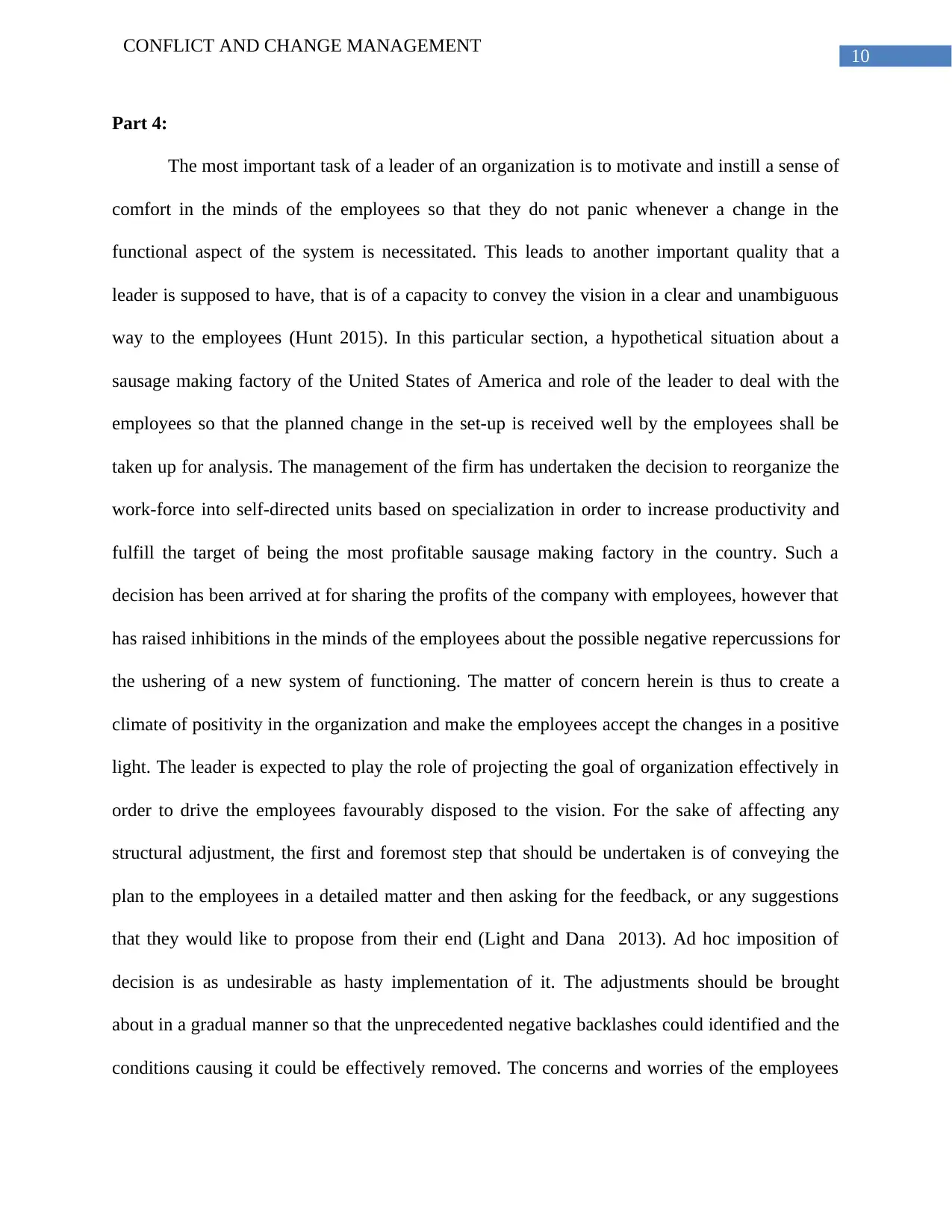
10
CONFLICT AND CHANGE MANAGEMENT
Part 4:
The most important task of a leader of an organization is to motivate and instill a sense of
comfort in the minds of the employees so that they do not panic whenever a change in the
functional aspect of the system is necessitated. This leads to another important quality that a
leader is supposed to have, that is of a capacity to convey the vision in a clear and unambiguous
way to the employees (Hunt 2015). In this particular section, a hypothetical situation about a
sausage making factory of the United States of America and role of the leader to deal with the
employees so that the planned change in the set-up is received well by the employees shall be
taken up for analysis. The management of the firm has undertaken the decision to reorganize the
work-force into self-directed units based on specialization in order to increase productivity and
fulfill the target of being the most profitable sausage making factory in the country. Such a
decision has been arrived at for sharing the profits of the company with employees, however that
has raised inhibitions in the minds of the employees about the possible negative repercussions for
the ushering of a new system of functioning. The matter of concern herein is thus to create a
climate of positivity in the organization and make the employees accept the changes in a positive
light. The leader is expected to play the role of projecting the goal of organization effectively in
order to drive the employees favourably disposed to the vision. For the sake of affecting any
structural adjustment, the first and foremost step that should be undertaken is of conveying the
plan to the employees in a detailed matter and then asking for the feedback, or any suggestions
that they would like to propose from their end (Light and Dana 2013). Ad hoc imposition of
decision is as undesirable as hasty implementation of it. The adjustments should be brought
about in a gradual manner so that the unprecedented negative backlashes could identified and the
conditions causing it could be effectively removed. The concerns and worries of the employees
CONFLICT AND CHANGE MANAGEMENT
Part 4:
The most important task of a leader of an organization is to motivate and instill a sense of
comfort in the minds of the employees so that they do not panic whenever a change in the
functional aspect of the system is necessitated. This leads to another important quality that a
leader is supposed to have, that is of a capacity to convey the vision in a clear and unambiguous
way to the employees (Hunt 2015). In this particular section, a hypothetical situation about a
sausage making factory of the United States of America and role of the leader to deal with the
employees so that the planned change in the set-up is received well by the employees shall be
taken up for analysis. The management of the firm has undertaken the decision to reorganize the
work-force into self-directed units based on specialization in order to increase productivity and
fulfill the target of being the most profitable sausage making factory in the country. Such a
decision has been arrived at for sharing the profits of the company with employees, however that
has raised inhibitions in the minds of the employees about the possible negative repercussions for
the ushering of a new system of functioning. The matter of concern herein is thus to create a
climate of positivity in the organization and make the employees accept the changes in a positive
light. The leader is expected to play the role of projecting the goal of organization effectively in
order to drive the employees favourably disposed to the vision. For the sake of affecting any
structural adjustment, the first and foremost step that should be undertaken is of conveying the
plan to the employees in a detailed matter and then asking for the feedback, or any suggestions
that they would like to propose from their end (Light and Dana 2013). Ad hoc imposition of
decision is as undesirable as hasty implementation of it. The adjustments should be brought
about in a gradual manner so that the unprecedented negative backlashes could identified and the
conditions causing it could be effectively removed. The concerns and worries of the employees
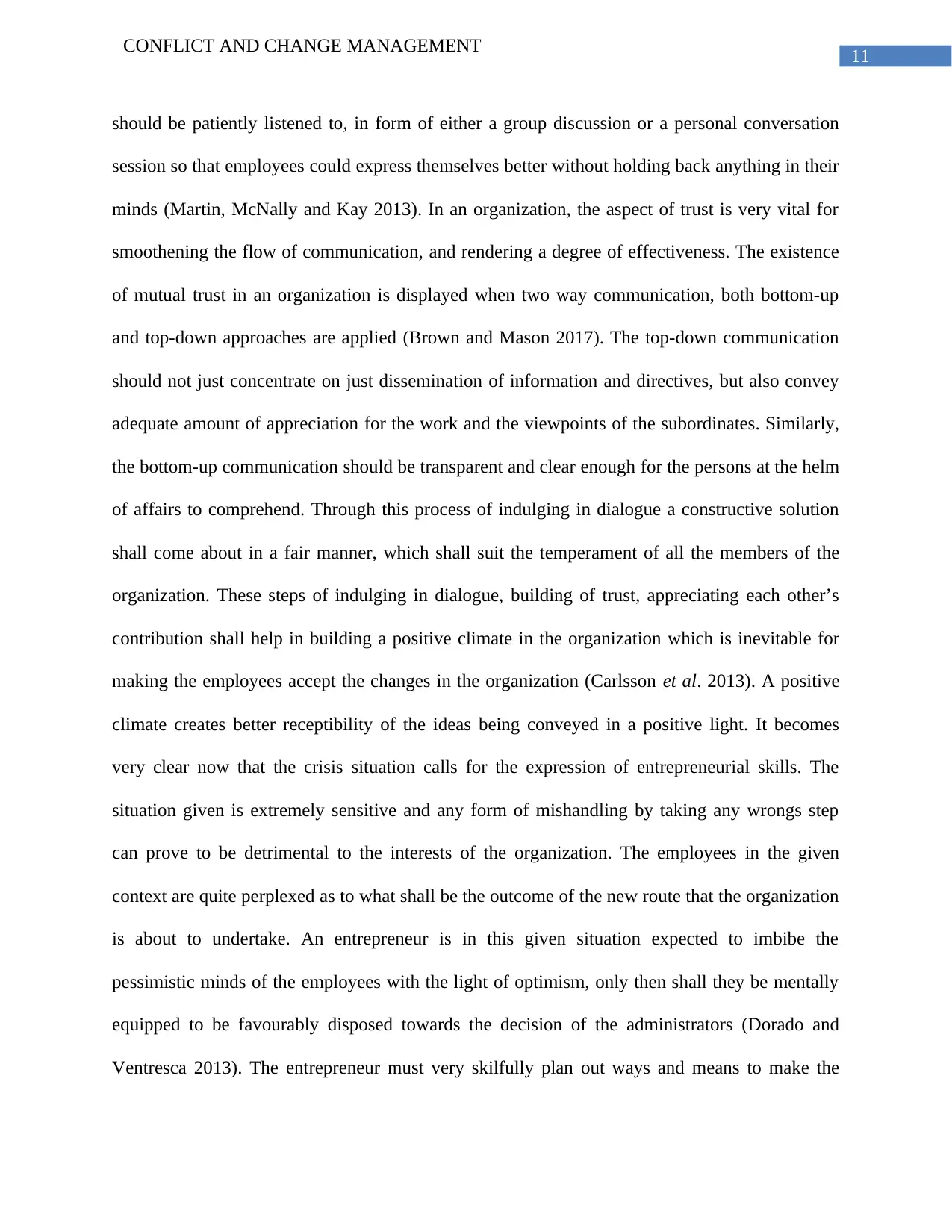
11
CONFLICT AND CHANGE MANAGEMENT
should be patiently listened to, in form of either a group discussion or a personal conversation
session so that employees could express themselves better without holding back anything in their
minds (Martin, McNally and Kay 2013). In an organization, the aspect of trust is very vital for
smoothening the flow of communication, and rendering a degree of effectiveness. The existence
of mutual trust in an organization is displayed when two way communication, both bottom-up
and top-down approaches are applied (Brown and Mason 2017). The top-down communication
should not just concentrate on just dissemination of information and directives, but also convey
adequate amount of appreciation for the work and the viewpoints of the subordinates. Similarly,
the bottom-up communication should be transparent and clear enough for the persons at the helm
of affairs to comprehend. Through this process of indulging in dialogue a constructive solution
shall come about in a fair manner, which shall suit the temperament of all the members of the
organization. These steps of indulging in dialogue, building of trust, appreciating each other’s
contribution shall help in building a positive climate in the organization which is inevitable for
making the employees accept the changes in the organization (Carlsson et al. 2013). A positive
climate creates better receptibility of the ideas being conveyed in a positive light. It becomes
very clear now that the crisis situation calls for the expression of entrepreneurial skills. The
situation given is extremely sensitive and any form of mishandling by taking any wrongs step
can prove to be detrimental to the interests of the organization. The employees in the given
context are quite perplexed as to what shall be the outcome of the new route that the organization
is about to undertake. An entrepreneur is in this given situation expected to imbibe the
pessimistic minds of the employees with the light of optimism, only then shall they be mentally
equipped to be favourably disposed towards the decision of the administrators (Dorado and
Ventresca 2013). The entrepreneur must very skilfully plan out ways and means to make the
CONFLICT AND CHANGE MANAGEMENT
should be patiently listened to, in form of either a group discussion or a personal conversation
session so that employees could express themselves better without holding back anything in their
minds (Martin, McNally and Kay 2013). In an organization, the aspect of trust is very vital for
smoothening the flow of communication, and rendering a degree of effectiveness. The existence
of mutual trust in an organization is displayed when two way communication, both bottom-up
and top-down approaches are applied (Brown and Mason 2017). The top-down communication
should not just concentrate on just dissemination of information and directives, but also convey
adequate amount of appreciation for the work and the viewpoints of the subordinates. Similarly,
the bottom-up communication should be transparent and clear enough for the persons at the helm
of affairs to comprehend. Through this process of indulging in dialogue a constructive solution
shall come about in a fair manner, which shall suit the temperament of all the members of the
organization. These steps of indulging in dialogue, building of trust, appreciating each other’s
contribution shall help in building a positive climate in the organization which is inevitable for
making the employees accept the changes in the organization (Carlsson et al. 2013). A positive
climate creates better receptibility of the ideas being conveyed in a positive light. It becomes
very clear now that the crisis situation calls for the expression of entrepreneurial skills. The
situation given is extremely sensitive and any form of mishandling by taking any wrongs step
can prove to be detrimental to the interests of the organization. The employees in the given
context are quite perplexed as to what shall be the outcome of the new route that the organization
is about to undertake. An entrepreneur is in this given situation expected to imbibe the
pessimistic minds of the employees with the light of optimism, only then shall they be mentally
equipped to be favourably disposed towards the decision of the administrators (Dorado and
Ventresca 2013). The entrepreneur must very skilfully plan out ways and means to make the
⊘ This is a preview!⊘
Do you want full access?
Subscribe today to unlock all pages.

Trusted by 1+ million students worldwide
1 out of 18
Related Documents
Your All-in-One AI-Powered Toolkit for Academic Success.
+13062052269
info@desklib.com
Available 24*7 on WhatsApp / Email
![[object Object]](/_next/static/media/star-bottom.7253800d.svg)
Unlock your academic potential
Copyright © 2020–2025 A2Z Services. All Rights Reserved. Developed and managed by ZUCOL.





